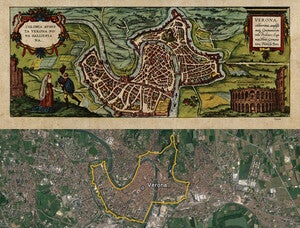
Georg Braun, Frans Hogenberg
from Civitates Orbis Terrarum
c. 1600-23
Verona is perhaps best known as the setting of Shakespeare’s Romeo and Juliet. The city at the time this map was published was a picturesque layering of ancient Roman architecture as well as medieval and Renaissance Era structures.
Some notable landmarks include the Verona Arena, the Roman style amphitheater located in the center of the illustration and the Castelvecchio, the large castle just west of the arena. Another notable feature is the system of walls surrounding the city, spanning both sides of Adige River. Stretching over 10 km, the walls are a reflection of the city’s extensive history. Originally built by the Romans, they went through cycles of disrepair and restructuring throughout the centuries. Yet in most places, the base of the walls are still of the original Roman build. Whereas some cities underwent rapid change during the past few centuries, old Verona has stayed mostly the same albeit sprawling out into the neighboring countryside.
The city walls, the arena, even the streets remain nearly the same for this quaint city on the Adige River. Below the map is a modern view of the city with the walls outlined, as closely as possible, as depicted on the map for comparison.
Compare to the modern city in detail with this Google map.
by Hoon Kang, Map and Geospatial Hub student employee